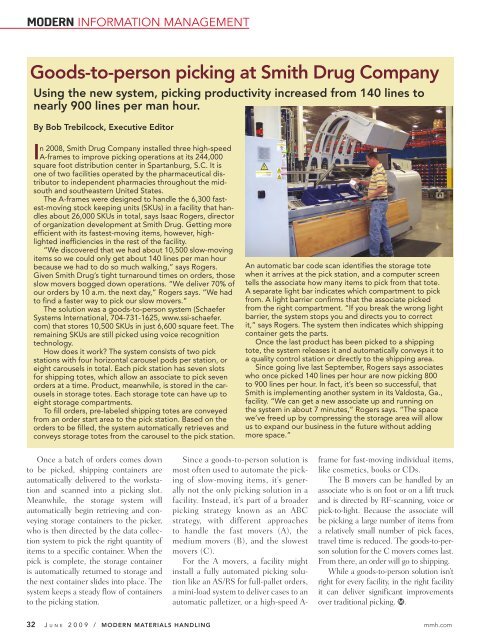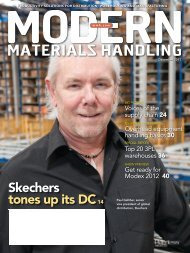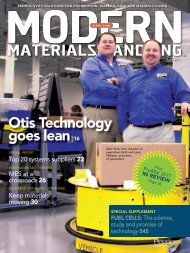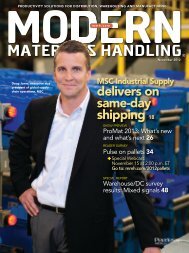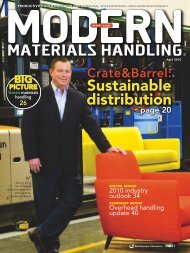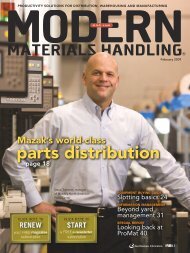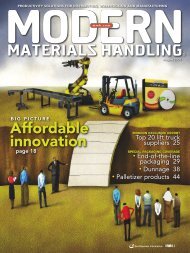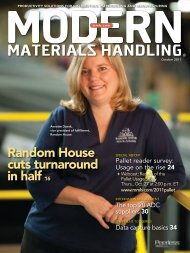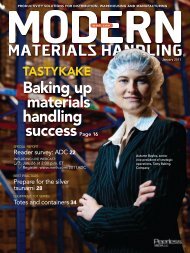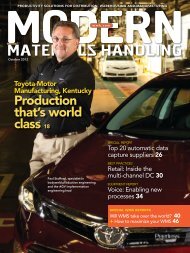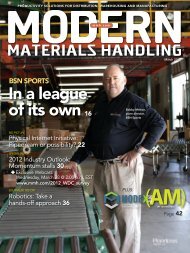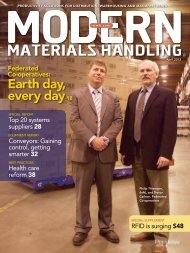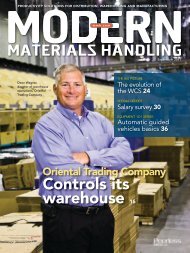June - Modern Materials Handling
June - Modern Materials Handling
June - Modern Materials Handling
- No tags were found...
You also want an ePaper? Increase the reach of your titles
YUMPU automatically turns print PDFs into web optimized ePapers that Google loves.
modern INFORMATION MANAGEMENTGoods-to-person picking at Smith Drug CompanyUsing the new system, picking productivity increased from 140 lines tonearly 900 lines per man hour.By Bob Trebilcock, Executive EditorIn 2008, Smith Drug Company installed three high-speedA-frames to improve picking operations at its 244,000square foot distribution center in Spartanburg, S.C. It isone of two facilities operated by the pharmaceutical distributorto independent pharmacies throughout the midsouthand southeastern United States.The A-frames were designed to handle the 6,300 fastest-movingstock keeping units (SKUs) in a facility that handlesabout 26,000 SKUs in total, says Isaac Rogers, directorof organization development at Smith Drug. Getting moreefficient with its fastest-moving items, however, highlightedinefficiencies in the rest of the facility.“We discovered that we had about 10,500 slow-movingitems so we could only get about 140 lines per man hourbecause we had to do so much walking,” says Rogers.Given Smith Drug’s tight turnaround times on orders, thoseslow movers bogged down operations. “We deliver 70% ofour orders by 10 a.m. the next day,” Rogers says. “We hadto find a faster way to pick our slow movers.”The solution was a goods-to-person system (SchaeferSystems International, 704-731-1625, www.ssi-schaefer.com) that stores 10,500 SKUs in just 6,600 square feet. Theremaining SKUs are still picked using voice recognitiontechnology.How does it work? The system consists of two pickstations with four horizontal carousel pods per station, oreight carousels in total. Each pick station has seven slotsfor shipping totes, which allow an associate to pick sevenorders at a time. Product, meanwhile, is stored in the carouselsin storage totes. Each storage tote can have up toeight storage compartments.To fill orders, pre-labeled shipping totes are conveyedfrom an order start area to the pick station. Based on theorders to be filled, the system automatically retrieves andconveys storage totes from the carousel to the pick station.An automatic bar code scan identifies the storage totewhen it arrives at the pick station, and a computer screentells the associate how many items to pick from that tote.A separate light bar indicates which compartment to pickfrom. A light barrier confirms that the associate pickedfrom the right compartment. “If you break the wrong lightbarrier, the system stops you and directs you to correctit,” says Rogers. The system then indicates which shippingcontainer gets the parts.Once the last product has been picked to a shippingtote, the system releases it and automatically conveys it toa quality control station or directly to the shipping area.Since going live last September, Rogers says associateswho once picked 140 lines per hour are now picking 800to 900 lines per hour. In fact, it’s been so successful, thatSmith is implementing another system in its Valdosta, Ga.,facility. “We can get a new associate up and running onthe system in about 7 minutes,” Rogers says. “The spacewe’ve freed up by compressing the storage area will allowus to expand our business in the future without addingmore space.”Once a batch of orders comes downto be picked, shipping containers areautomatically delivered to the workstationand scanned into a picking slot.Meanwhile, the storage system willautomatically begin retrieving and conveyingstorage containers to the picker,who is then directed by the data collectionsystem to pick the right quantity ofitems to a specific container. When thepick is complete, the storage containeris automatically returned to storage andthe next container slides into place. Thesystem keeps a steady flow of containersto the picking station.Since a goods-to-person solution ismost often used to automate the pickingof slow-moving items, it’s generallynot the only picking solution in afacility. Instead, it’s part of a broaderpicking strategy known as an ABCstrategy, with different approachesto handle the fast movers (A), themedium movers (B), and the slowestmovers (C).For the A movers, a facility mightinstall a fully automated picking solutionlike an AS/RS for full-pallet orders,a mini-load system to deliver cases to anautomatic palletizer, or a high-speed A-frame for fast-moving individual items,like cosmetics, books or CDs.The B movers can be handled by anassociate who is on foot or on a lift truckand is directed by RF-scanning, voice orpick-to-light. Because the associate willbe picking a large number of items froma relatively small number of pick faces,travel time is reduced. The goods-to-personsolution for the C movers comes last.From there, an order will go to shipping.While a goods-to-person solution isn’tright for every facility, in the right facilityit can deliver significant improvementsover traditional picking. .32 J UNE 2009 / MODERN MATERIALS HANDLING mmh.com


